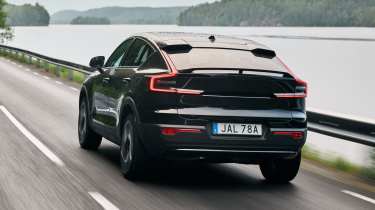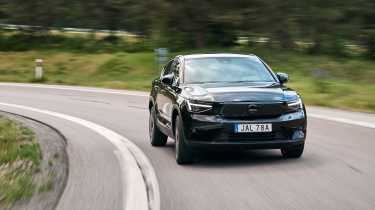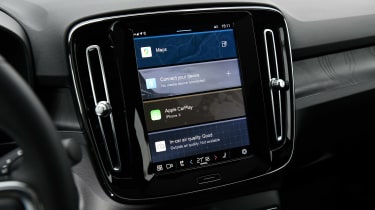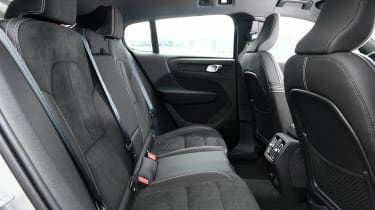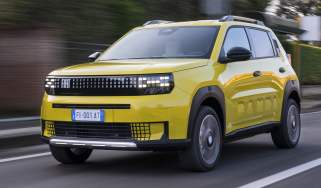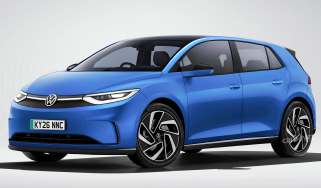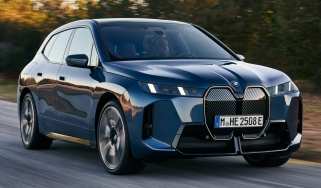Volvo EC40 review – Volvo’s electric coupe-SUV
“The Volvo EC40 is an electric-only version of the EX40 SUV with coupe-like styling”
Pros
- Fast
- Quality interior
- Lots of safety features
Cons
- Expensive subscription service
- Not much fun to drive
- Efficiency could be better
Verdict – is the Volvo EC40 a good car?
The Volvo EC40 is a very competent car because it’s good to drive, well built, full of modern tech and has a big battery for plenty of range. Despite this it’s still hard to recommend, simply because the electric version of the XC40, the EX40, is good in all the same ways, yet it’s also more practical. Plus, if you want something more stylish, there’s also the Polestar 2 from Volvo’s sister brand, which is even better to drive.
Volvo EC40 models, specs and alternatives
The Volvo EC40 was the first model from the Swedish car maker to be powered by electric motors only – there are no petrol or diesel versions. However, it’s not really a completely stand-alone model, because it’s very closely related to the XC40 SUV and its all-electric spin-off, the Volvo EX40. The EC40 is a bit sleeker and more coupe-like than the EX40 but still has an upright stance like its sister model. It was originally launched as the Volvo C40 Recharge, but was renamed the EC40 to suit Volvo’s latest naming system in 2024, just as the XC40 Recharge was redubbed the EX40.
The Volvo EC40 is no longer the brand’s smallest electric model – that title has been taken by the more affordable Volvo EX30. The EC40 is similar in size to an Audi Q3, which is considered a medium-sized SUV in most places.
More reviews
In-depth reviews
While the EC40 is slightly more aerodynamic than the XC40 and gets ever so slightly more range than the EX40, it’s less practical than its stablemate because the boot is a bit smaller. It’s also more expensive than an equivalent EX40 so you’ll have to really love the way it looks for the EC40 to appeal more than its sister model.
The main rivals for the Volvo EC40 are the Audi Q4 e-tron Sportback (a sleeker version of the Q4 e-tron with a lower roofline) the Smart #3 and the Genesis GV60. You might also consider the Genesis’ sister car, the Kia EV6 – it’s cheaper than the Volvo yet better to drive and packed with tech. Other premium alternatives include the BMW iX1 (the electric version of the BMW X1) and the Tesla Model Y which is very good for range and tech but isn’t as well-built as the Volvo. Skoda even offers a coupe version of its Enyaq electric SUV which is cheaper and more spacious.
Originally, single-motor models were front-wheel drive, but an update in 2023 brought a switch to rear-wheel drive in the pursuit of greater efficiency and a longer range. According to official figures, single-motor versions with a 69kWh battery get up to 300 miles on a charge, though while our experience showed the EC40 to be more economical than its predecessor, we reckon 220-240 miles is more realistic. Twin Motor models, with their larger 82kWh batteries, should be able to eke out roughly 340 miles according to official figures, and there’s a Single Motor Extended Range model with a 78kWh battery that can manage up to 345 miles.
The range-topping Volvo EC40 Twin models are the quickest, and like the EX40 and similarly to the Polestar 2, you get 402bhp and a sub-five-second 0-62mph time, which is almost on a par with the Tesla Model Y. We think single-motor variants should prove quick enough for most buyers, however.
With 235bhp and 249bhp (heavier, larger-battery Extended Range models get some extra oomph), these versions do 0-62mph in a still impressive 7.3 seconds, with a cost saving of around £3,000 compared with the dual-motor version. Their introduction makes the EC40 a more appealing option as few buyers need the huge performance figures of the all-wheel drive versions.
The two trim levels are Plus and Ultra. All cars get LED lights, 19-inch aero alloy wheels, a power-operated tailgate and textile upholstery. The nine-inch portrait touchscreen feels a little small alongside more modern rivals but it now runs Android Automotive software, which means that instead of Volvo having its own sat-nav system, Google Maps is baked in. You still get Apple CarPlay and Android Auto, though it’s not wireless like in most cars in this class.
Rear visibility is affected by a spoiler and steeply-raked rear windscreen, but otherwise, practicality is reasonable; the back seats are still pretty spacious and the sloping roofline doesn’t cut into headroom too badly. The boot is smaller than that of the XC40 but EC40 buyers are unlikely to mind the compromise and there’s no load lip to haul heavy items over.
Recent updates mean the EC40 is better than ever, but with flagship cars topping out at over £55,000, Volvo’s first standalone EV sits alarmingly close to rivals in the class above. The brand’s car subscription service, which takes a lot of the stress out of car ownership, bundling things like servicing, VED (road tax), roadside assistance and even replacement tyres.
|
Trim levels |
Power options |
|
|
Volvo EC40 alternatives
Premium small electric SUVs
Hybrid SUVs
- Range Rover Evoque PHEV
- BMW X1 PHEV
- Volvo XC40 T5 Recharge PHEV
Petrol SUVs
- BMW X1 xDrive23i
- Volvo XC40 B3
- Audi Q3 35 TFSI
- Mercedes GLA 200
Range, charging & running costs
While the Volvo EC40 entered the market after a lot of its rivals, its EX40-derived technology meant its figures didn’t look so good compared to the Hyundai Ioniq 5, Volkswagen ID.4 and Ford Mustang Mach-E. However, updates to cars built from mid-2023 saw the Volvo gain a more competitive edge; a range of up to 345 miles (278 miles previously) is about as good as anything in this class.
To get that, however, you’ll need to fork out for the Single Motor Extended Range with the 78kWh battery. Standard Single Motor cars get up to 300 miles to a charge with a 69kWh battery, and the Twin Motor model’s 82kWh battery delivers up to 340 miles, sacrificing some efficiency for higher performance.
While range and efficiency have improved on later cars, we still don’t think many people will get close to those claimed figures. Our experience with a new single-motor rear-wheel drive EC40 showed a figure of around 3.3-3.4mi/kWh is reasonable – meaning a range of around 220-240 miles in cooler temperatures. The Twin Motor car should return closer to 270-290 miles in similar conditions.
Fast-charging was supported at up to 150kW from launch. This has since increased to 200kW, reducing the charging time from 10 to 80% to 28 minutes. A change in battery supplier for the single-motor models means that these cars now top out at just 130kW – so that same benchmark charge takes 33 minutes, despite the smaller battery. Volvo recommends an 11kW charger for home use, which takes between 11 to 13 hours to recharge fully depending on the size of the battery. But check your home is capable of accepting a three-phase charger; if it isn’t, a more common 7kW wallbox will take a little longer to top it up.
The brand's Care by Volvo subscription service puts everything into one handy (albeit expensive) monthly payment, including VED (road tax) and MOT inspections, which sounds great until you realise that the car is free to tax (until VED applies to EVs from 2025) because it’s electric, and the car will only need an MOT at the end of your 36-month contract. Servicing and maintenance is also included but again, this should be far cheaper than a petrol or diesel car. Volvo even says the electric motors are sealed for life and maintenance-free, so you may question the value-for-money of the subscription deal.
The subscription does include 30 days’ insurance and the Volvo EC40 sits in a high insurance group. Standard single-motor models range from groups 37 to 39 out of 50, while Twin EC40 models in Plus or Ultra trim sit in group 43, so make sure to get a quote before you buy. It’s worth noting that the Tesla Model Y is in the very top group and will be even more expensive to insure, however.
|
Model |
Battery size |
Range |
|
Single motor |
69kWh |
300 miles |
| Single motor extended range | 78kWh | 345 miles |
|
Twin motor |
82kWh |
340 miles |
Electric motor, drive & performance
Both versions of the EC40 feature a familiar powertrain, with the range-topping Recharge Twin featuring an electric motor on each axle to give four-wheel drive. The result is 402bhp and a 0-62mph time of just 4.7 seconds – and in our experience, that figure feels conservative. Unlike some EVs, which tend to soften the throttle response when you first press it, the EC40 seems to provide the full thrust of the electric motors instantly.
Not that the Volvo EC40 Twin is designed to be a sports car. The steering is light and short of feel, and firming up the steering via the infotainment menus doesn’t add much excitement. As a result, it feels like the huge performance is a bit unnecessary, and perhaps even over-the-top. If you are keen on performance driving, the lower-slung Polestar 2 with the same powertrain makes more sense, as it’s much more fun to drive.
The EC40 range diversified when the single-motor options were introduced – these now offer 235bhp (Extended Range gets 249bhp) with identical 0-62mph times of 7.3 seconds. These models were updated in late 2022 (for production later in 2023), switching the all-electric layout from front to rear-wheel drive – with a small power boost.
Our experience with the front-wheel drive single-motor cars showed that despite offering almost half the power of the Twin versions, performance was more than adequate, with the instant torque from the electric motor making it feel plenty fast enough in normal driving. The switch to a rear motor isn’t easy to spot in normal driving, but the car does feel a bit grippier through tight bends or when asking for full acceleration out of junctions. Either way, these less powerful models will make more sense for many buyers.
As well as avoiding the dual-motor cars, we’d also steer clear of top-spec Ultra models and their larger 20-inch wheels. These don’t do the ride any favours, and they generate more road noise as well. Plus cars are more comfortable as a result.
|
Model |
Power |
0-62mph |
Top speed |
|
Single motor |
235bhp |
7.3s |
112mph |
| Single motor extended range | 249bhp | 7.3s | 112mph |
|
Twin motor |
402bhp |
4.7s |
112mph |
Interior & comfort
Step inside the EC40 and you could be in any current Volvo. That’s not a bad thing because it feels high-quality and calmer than some German interior designs. To improve sustainability, there’s no leather anywhere in the cabin, and there’s no starter button either. Simply get in and select ‘D’ and the EC40 will set off when you lift off the brake.
A nine-inch touchscreen is included, which despite feeling a little small, runs a new Android Automotive software package. Volvo graphics hide a Google package, with Google’s apps being used for things like navigation and speech recognition. It works better than any manufacturer software and it’s an improvement on Android Auto – and not just because you don’t have to plug your phone in to use it. More apps are being added all the time; popular sat-nav app Waze is now downloadable via the Google Play store.
Regardless, using the built-in Google Maps is straightforward, and it even shows you how much range you’ll have left when you reach your destination – suggesting charging stops en-route if necessary. The infotainment setup now also supports Apple CarPlay, so iPhone users are also catered for – with the setup now filling the entire portrait-orientated screen unlike in older Volvos.
It’s a shame you have to adjust the climate control and heated seats via the screen, however, because despite being fairly responsive, it still requires taking your eyes off the road – unlike if the EC40 were fitted with physical controls.
All cars also come with a configurable digital instrument cluster, though in some respects, the information displayed may be too minimal for drivers used to other brands. However, while Volvo previously chose to display range as a percentage rather than giving you your remaining miles, the 2023 update added functionality for the latter – so you no longer have to drill down into the Range Assistant on the central display to see the necessary numbers. It isn’t yet clear whether this will be added to older models over the air in time..
Trim levels are Plus and Ultra, and standard equipment includes the digital instrument cluster, LED headlights and foglights, a heat pump that helps keep the battery at an optimum temperature to conserve range and heat the cabin and ‘Pilot Assist’ – Volvo’s smart cruise control which can also keep the EC40 in its lane on the motorway. Ultimate was renamed Ultra in 2024 and brings Pixel LED adaptive headlights, 20-inch alloy wheels, a Harman Kardon sound system with 12 speakers and a subwoofer and ambient lighting.
As with many other cars in the Volvo lineup, a Black Edition was added, bringing gloss black exterior elements for a classy look.
A retractable towbar costs £1,400, but most other options are now simply included in the price of their relative trim levels, unless you want to change your paint colour or alloy wheels.
|
Key features | ||
|
Plus
|
Ultimate (Plus, plus…)
| |
Practicality & boot space
Coupe SUVs like the Volvo EC40 offer extra style at the expense of practicality, so buyers should be prepared for it to be slightly less spacious than the standard XC40. The EC40 is still a practical car, however, with enough headroom in the rear seats and plenty of legroom too. You won’t be able to see much out the narrow rear window but the standard XC40’s chunky rear pillars mean that car suffers from compromised rear visibility as well.
|
Size comparison | |||
|
Model |
Length |
Width |
Height |
|
Volvo EC40 |
4,440mm |
1,910mm |
1,591mm |
|
BMW iX1 |
4,500mm |
1,845mm |
1,616mm |
|
Mercedes EQA |
4,463mm |
1,834mm |
1,615mm |
|
Lexus UX 300e |
4,495mm |
1,840mm |
1,545mm |
Boot space
The interior includes a good selection of big storage compartments and cup holders, and the boot space is reasonable at 413 litres – about the same as a Ford Mustang Mach-E, but slightly down on the 452 litres of the EX40. Some rivals, including the BMW iX1, have more space, too. The biggest issue we found in both Volvos was the rigid parcel shelf; a retractable roller-style setup is more practical – if you’re loading the EC40 up to the rear windows, you may find you need to leave the parcel shelf at home.
The Volvo scores extra points for its wide boot opening, however, and how easy it is to load bulky items, which is helped by the absence of a load lip; the boot floor is at the same level as the bottom of the tailgate. There’s space under the boot floor for valuables or mucky boots, and there’s also a front trunk under the bonnet, providing extra storage and an easy place to keep your cables. We’d like all electric cars to come with a ‘frunk’ but some, like the Volkswagen ID.4, don’t.
Electric cars can’t often tow but the EC40 can haul a braked trailer weighing up to 1,800kg. That’s a decent figure for any car, let alone an electric one, so it’d be absolutely fine to tow a caravan or even a smallish car on a trailer. Range will suffer, however.
|
Boot space comparison | |
|
Model |
Boot space |
|
Volvo EC40 |
413 litres |
|
BMW iX1 |
490 litres |
|
Mercedes EQA |
340 litres |
|
Lexus UX 300e |
367 litres |
Reliability and safety
Volvo is known for the safety credentials of its cars and the EC40 is no different. Just like the mechanically similar Volvo EX40, the EC40 scored the maximum five-star score, with an impressive 92% rating for adult occupant protection from Euro NCAP. A wide range of driver assistance systems are available, including lane-keeping assist, blind-spot monitoring, an alert that warns you if anything is crossing behind you when you reverse, and autonomous emergency braking that can detect vehicles, pedestrians, cyclists and large animals. A 360-degree parking camera will also make it easier to get in and out of tight spaces.
While the EC40 hasn’t appeared in our Driver Power owner satisfaction survey, the closely-related XC40 has, and in 2021 it achieved a stellar eighth-place finish out of the top 75 cars rated – it’s dropped slightly since, coming in 32nd place out of 50 models in 2024. Besides running costs and value, which are less relevant for the electric EC40 anyway, every other aspect was rated highly, especially the interior and safety features. Volvo also scored an eighth-place finish in our run-down of the best brands in 2023, although almost 28% of owners reported faults in the first year. That’s a little worrying but the XC40’s good score for reliability may suggest that most problems were minor niggles and glitches, rather than major issues.

